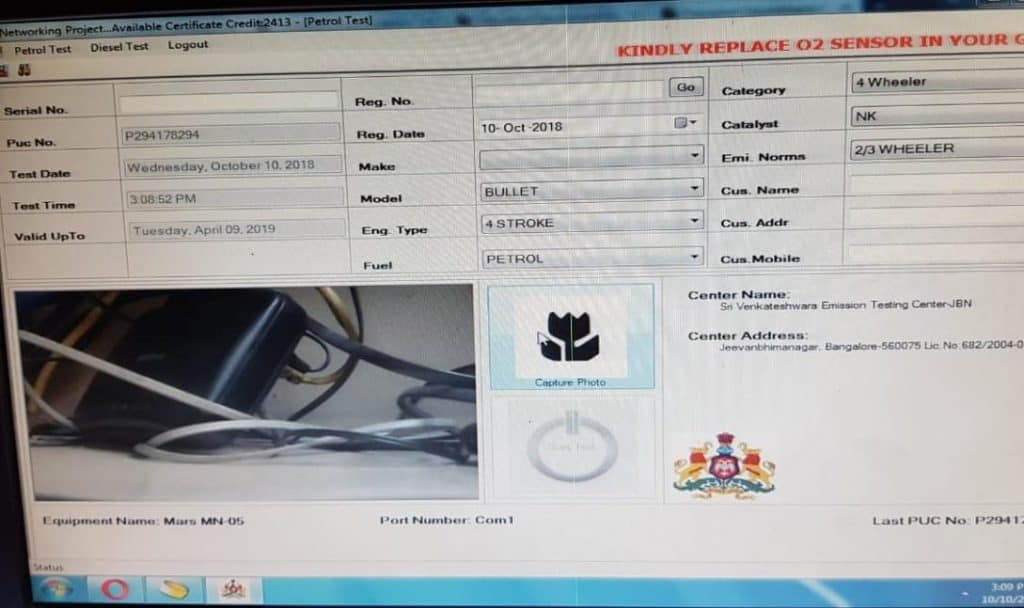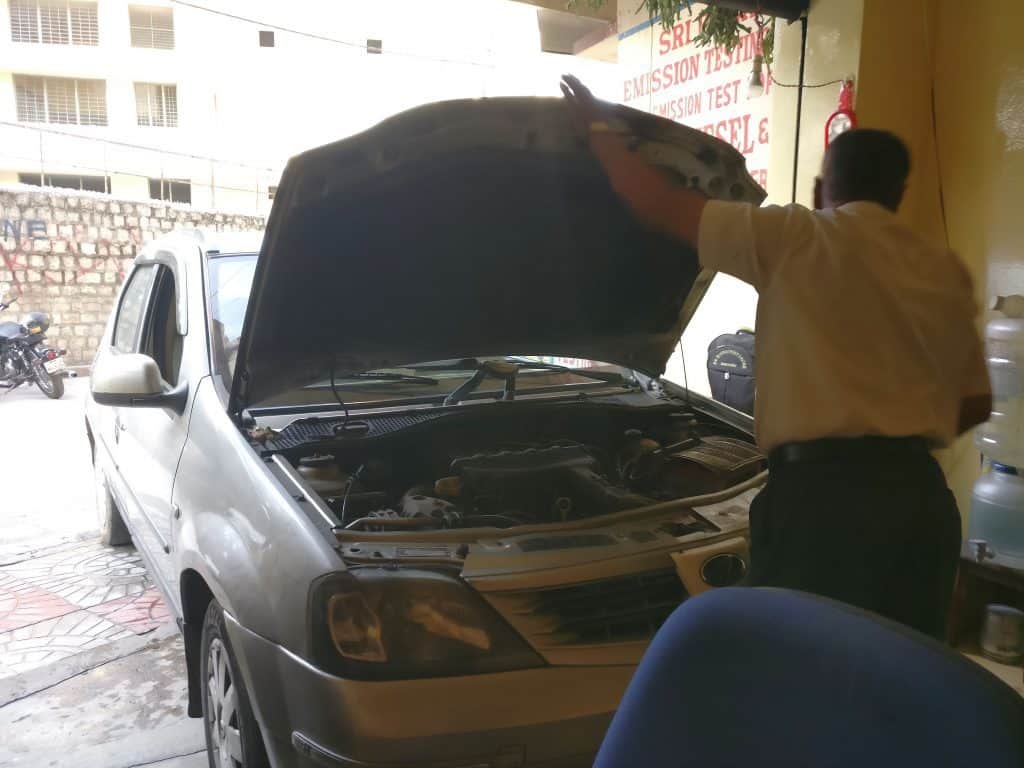This article is part of a special series: Air Quality in our Cities |
Over the years Bengaluru has seen a exponential increase in the number of registered vehicles; with the official data at 73 lakh vehicles as of January 2018. Out of these, 50 lakh vehicles are two-wheelers, while there are 14 lakh four-wheelers. One of the major causes of air pollution in mega cities in India such as Bengaluru is due to the emission from transportation sources.
In a recent study by Centre for Science and Environment, Bengaluru ranked third among 14 metropolitan cities in India in terms of overall aggregated emission and energy use from urban commute; and third in terms of per travel emissions and energy use. The study mentions how Bengaluru and Chennai have the highest annual growth rate for vehicles in the country; and the only reason why Delhi has a much higher aggregate emission and energy use is due to its higher population.
There is an urgent need to cut down on emission levels. Various solutions ranging from the promotion and improvement of mass public transport system to improving infrastructure for cycling and walking etc, have been widely debated and discussed.
This article examines the mechanisms currently present in Bengaluru to ensure that registered vehicles follow regular emission control checks.
Pollution Under Control (PUC) Certificate
PUC test is the only mechanism currently used to determine emission levels of individual vehicles to ensure that they are in compliance with the Bharat Stage 4 Emission standard in place now. Bharat Stage Emission standards are instituted by the Government of India to measure the production of air pollutants from internal combustion engine equipment. There are currently over 300 centers in Bengaluru and over 700 centers in Karnataka that are authorised to test and provide the Pollution Under Control (PUC) certificate.
The centres are present in select petrol stations, in a kiosk or spot rented out by the bunk owners. Citizen Matters spoke to a proprietor of one such emission testing center for diesel and petrol vehicles. The proprietor Prabhu (name changed) has been running the centre for more than 14 years. Every six months his centre is inspected by the Regional Transport Office (RTO) officials, who check the calibration and functioning of the equipments. Prabhu says he gets around 30- 35 customers on average every day. He claims that around 150 vehicles (almost 5 per day) fail the emission tests which are usually two-stroke vehicles, and other older vehicles.
Emission testing process
The software CPUCNET is used at emission testing centers across Karnataka. Depending on the type of vehicle (diesel/petrol etc); there are separate tabs to enter the details of the vehicle and the owner. Separate probes for diesel and petrol connect to smoke meters attached to the computer.

Figure 1: The page where vehicle and owner details need to be entered
The emission tests starts with the picture of the license plate being taken using a camera attached to the computer. The picture emerges on the software; and when the license plate number is entered. The details of the bike including the model, engine type, registration date etc along with details of the person including name, phone number etc. appear on the software if the vehicle owner has previously entered their details on this software; otherwise the details need to be entered.
The probe is then placed inside the exhaust pipe of the vehicle. As the vehicle accelerates, the emission readings of Carbon monoxide (CO), Hydrocarbons (HC), Carbon dioxide (CO2) and Oxygen (O2) are registered on the screen. If the CO and HC readings are within a standard range, which varies based on the type of vehicle (cars, bikes etc); then the PUC certificate is provided, which contains the emission readings and details of the bike and the vehicle along with a hologram and authentication seal of the centre.
The PUC is valid for a period of six months for vehicles with Bharat Stage 3 engines and below, and one year for Bharat Stage 4 vehicles. The Supreme Court has banned the manufacture of Bharat stage 3 vehicles in 2017. If the emission levels are below the standard, the PUC certificate is not given; and the owner has to do the needful including servicing the vehicle, before taking the emission test again.
The emission test data is registered in the Transport Department’s database, and the history of one’s vehicular emissions tests can be accessed at the Transport Department’s website. A few vehicle owners that Citizen Matters spoke to mentioned that they even got reminder messages from the Department, when their test date was approaching.

Figure 2: After the emission results have been generated
Concerns around the emission testing process
Emission testing centers in Bengaluru have come under intense scrutiny in the last two years due to several malpractices such as flaws in the software that allows certificates to be issued without the presence of the vehicle.
Premalatha Sindhia- Public Relations Officer, Department of Transport, Karnataka, in a telephonic conversation with Citizen Matters , stated that currently their department has taken steps to closely monitoring Emission test centers. She added that earlier the software management was outsourced to the Karnataka State Electronic Development Corporation Limited; but presently their department has taken charge of it.
Inspection of PUC certificates
Citizen Matters spoke with traffic police personnel at various inspections points in and around Jeevan Bhima Nagar. They all said that they usually inspect for license card, the condition of the license plate, insurance documents, lack of helmet etc; and that the PUC certificate wasn’t a priority for them, even though they were authorised to inspect and fine based on the list of offences provided in their hand machine. They ask for the PUC certificate from riders when they see dark black fumes emerge from a vehicle.
“We also take action against vehicle owners and fine them if we get a complaint from citizens regarding emission issues with vehicles that they are aware of. There have been cases where people have mailed us about complaints,” said Revanna, a traffic police personnel with the Jeevan Bima Nagar Police Station. Traffic police personnel state that it is the responsibility of the RTO to inspect the vehicles for PUC certificates.

People are currently not fined for not getting emision test done. Pic: Shree D N
Mrs. Sindhia spoke about RTO officials empowered under the Central Motor Vehicles Act 1988 and its associated national and states rules; and employed at different parts of the city and one of their responsibility being inspection of vehicles for PUC certificates. But several reports have pointed to the concerns around staff shortage in Transport Department to conduct regular inspection.This point has been confirmed by Mrs. Sindhia; who stated that while their department is understaffed, there are trying to do the best with their limited resources.
Most don’t pay fines for failure to get emission test done
Citizen Matters spoke to ten residents of Bengaluru, who own and regularly operate their vehicles. Only a minority of them get their PUC certificates done on time. And these were people who have had experiences of being asked for PUC certificates in the past. The others get their vehicles inspected sporadically, whereas one responded hadn’t gotten his vehicle tested in several years.
None of them had to pay any fine due to having delayed taking the emission test. And majority of them said that even though they have been checked by Traffic Police in the past, they have not been asked for a PUC certificate. There are many news reports that say that there are a significant number of vehicle owners in Bengaluru who don’t get PUC certificates. And the tests conducted by Karnataka State Board Pollution Control (KSBPC) in 2017 using mobile vans showed that 20 percent of the vehicles tested in Bengaluru were flouting emissions norms.
Transport Department states that they have taken actions to minimise malpractice pertaining to Emission centers, conduct inspections through the RTO officials, fine Rs 1,000 for first time offenders and Rs 2,000 for the second time offenders, and are encouraging vehicle owners to regularly check their vehicular emissions by sending reminders.
While the fines are sizeable for both first time and second time offenders, the shortage of officials to inspect is a concern. The Department has emission details of vehicles stored in their database, but currently there isn’t a system to automatically penalise vehicle owners for not testing their vehicular emission levels on time. Thus, the current mechanisms aren’t robust enough and adequate to ensure that citizens fulfill their responsibility.
| This article is part of a special series: Air Quality in our Cities, and explores the root causes for air pollution and solutions for improving air quality in Bengaluru and Chennai. This series has supported with a grant from Climate Trends. |
Did you know the Industry are not required to test their smoke , whereas all vehicles are mandatory, ask any KSPCB officers, who will vouch for this,this is mentioned in their Consent Copies ( Lic. to operate) why do you people need Emission under control certificate, the fuel is supplied from Major PSU co.we citizen do,nt use adulterated fuel as Industry does, still they are exempted, what a LOGIC is this.
Even I have the same doubt the mechanisam of issuing PUC certificates and I doubt about
the credibility as I see daily so may vehicles emitting black smoke which is harmful for human respiratory system. Let me know if by anyway I can contribute to overcome this issue.
With due respect to the Depts concerned, PUC certificates can be procured for a fee. The buck passing between the Depts (in this case Police and RTO) ensures that things remain as they were.
This is called ‘progress’ in Karnataka.
Facility for getting emission test by vehicle owners should be available in all petrol bunks. But, in whichever petrol bunk you ask whether emission test arrangement is available, they say that it is not there. I am one such vehicle owner trying to get emission test done I was not successful in getting emission test done.
The Traffic Police should direct the petrol bunks to have that arrangement failing which the petrol bunk may be closed. Only then, the petrol bunks will install the emission test arrangement and vehicles owners will get it done.
The Traffic Police may enforce emission test certificate on all vehicles only after the petrol bunks follow the directions to provide emission test arrangement.
If I remember correctly, my vehicle is Bharat Stage IV. My certificate says, I have to get emission tested every 6 months. So, is this some other scam to force people to test every 6 months?
The BMTC buses are the main pollutants followed by Lorries, Tempos and Autos. Private cars and Two wheelers are probably the least. Unless strict measures are taken to control them with a strict law to restrict the usage of 15 year old vehicles like autos etc there can be no end to this polluted air that we are breathing everyday.